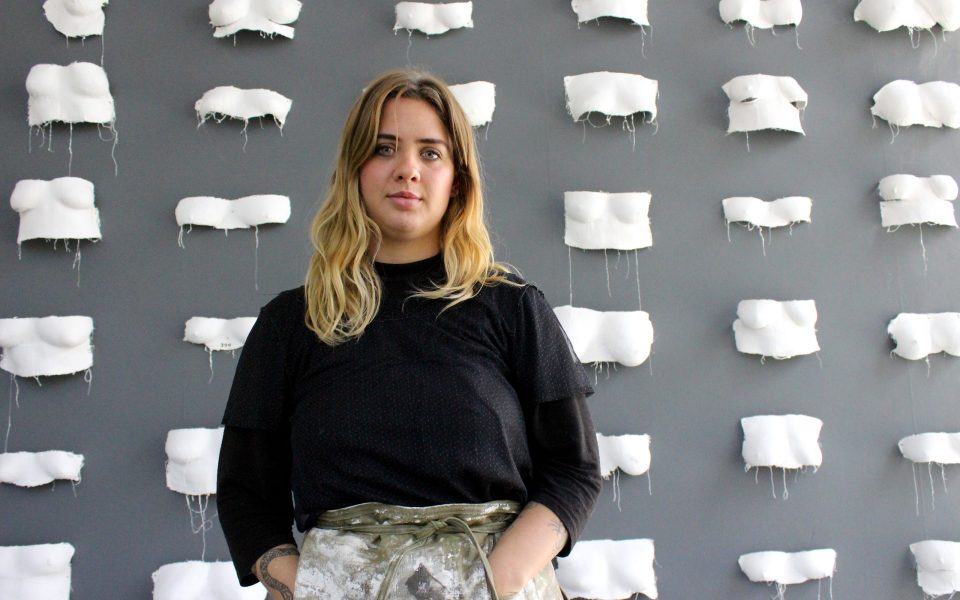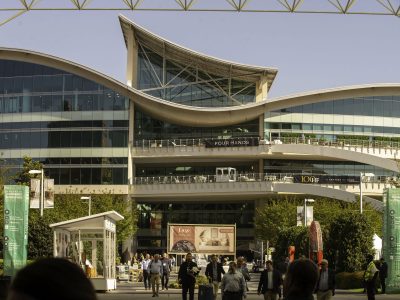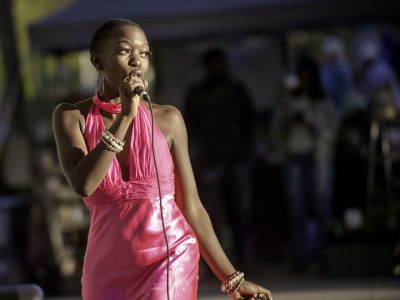Featured image: Artist Ali Waller plaster casts women’s bodies to tell survivor’s stories about sexual assault. (photo by Sayaka Matsuoka)
“What is your relationship with your body like?”
That’s how artist Ali Waller begins her conversations with models as she’s casting them. Her hands move gently as they place the cut, damp sheets of plaster onto her sister’s bare chest. The gauze-like material clings to her sister Emily’s body, emphasizing the curvature of her breasts and the sharpness of her clavicle. After a few minutes, the white, clay-like material begins to harden, forming a shell on top of her skin.
“I think it’s been changing in the last couple years,” her sister says in reply. “I think because of our childhood and growing up in such a conservative space, I think I grew up with a real antagonistic relationship to my own body and feeling like my own body was the enemy.”
This is Waller’s second time casting her sister’s body. The first time was for a previous show in which Waller cast several hundred women as a response to watching Filthy Rich, a documentary about abuse suffered by Jeffrey Epstein’s survivors. In the film, the women explain how they were paid $200 after being assaulted to keep them quiet. So, Waller set out to cast 200 bodies. That soon doubled and then tripled, and to date, she’s cast more than 850 bodies, including her own. On March 27, Waller’s show, /200 will open at SECCA in Winston-Salem; she will showcase close to 200 casts from past and more recent models. The show will run until June 13.

The topic of sexual assault cuts deeply for Waller, who explains that she was groomed and repeatedly assaulted by an older man over the course of three years, starting from when she was 13 years old. Being assaulted at such a young age tainted Waller’s perspective on sex and her relationship with her body, the artist, now 22, explains.
“I felt really manic, and I felt crazy,” she says. “No one had ever really told me that what happened was wrong. It wasn’t what people were saying, it’s that they weren’t saying anything at all.”
In 2017, Waller started going to EMDR therapy, eye movement desensitization and reprocessing, which she says helped her to start to heal. But then, the Epstein documentary was released
“EMDR radically changed all of that inner dialogue for me,” Waller says. “I had finally gotten to a place where I was no longer having these nightmares, I was feeling good and then the Epstein documentary came out.”
She says she watched the whole film in one sitting and immediately began researching the survivors and their stories.
“I felt this really present crossroads of, This will either make me go off the rails,” Waller remembers, “or ,I can still allow space for that energy and that rage but include the people that I know feel that way too, which is when I started to invite others.”
Waller has been creating art for years. She started in high school and continued afterwards, opting to apply for and participate in artist residencies rather than go the traditional higher education route. In the past she’s identified as a painter, but these days, she’s more of an installation artist, she says.
“I like space-making, especially when it comes to hypersensitive topics,” Waller says.
Since March 19, Waller has been inviting members of the public to book casting sessions to make imprints of their bodies. Since starting the series, she’s been prioritizing casting women because that’s the experience she relates to, but she also recognizes that men and non-binary individuals face sexual assault too. And not every person she’s cast has experienced sexual assault.
“It has reached a lot of non-binary folk and trans women because they experience the same struggles with anatomy, just in a different way,” Waller says. “I’ve done casts for trans women and non-binary people who have expressed not feeling able to identify as such because of what they have… and I think that’s as much the point as anything else.”
Waller’s show places an emphasis on bodily autonomy and the effects that surviving sexual assault can have, but the message digs into the deeper cultural realities about existing in a female body, too.
“We’ve put so much weight on bodies and perceptions of people rather than actually having these understandings of, Why do I see that and think that’s a woman or a sex object?” Waller poses.
From afar, the hundreds of upper bodies on the wall inside SECCA float in uniform rows. But upon closer inspection, no one chest is the same as another. Some feature larger breasts while others are more petite and compact. They’re beautiful and unique. But together, Waller says, they form a kind of army.

“The motivation is no longer anger or revenge, it’s solely for the survivor,” Waller says about the art. “I could care less about what is happening to this abuser now because I think if we give the proper attention to the survivor, the rest will fall in line.”
As Waller casts her models, she exudes a quiet empathy as she talks to the person sitting across from her. Once the plaster has hardened, forming a kind of armor, she invites the model to envision letting go of something, any thoughts or feelings they may have, as she pulls the cast off of their body. It’s a shedding of sorts; a cicada leaving its exuviae.
And then she says the lines that make her cry almost every time.
“You are one of 850 people now who see you, believe you, who are in support of you,” she says. “And you’ll never see what I see when I look at the installations, but people have said the same words as you, and this is a safe space that you’re included in.”
/200 opens at SECCA on March 27. To learn more, visit secca.org.
Join the First Amendment Society, a membership that goes directly to funding TCB‘s newsroom.
We believe that reporting can save the world.
The TCB First Amendment Society recognizes the vital role of a free, unfettered press with a bundling of local experiences designed to build community, and unique engagements with our newsroom that will help you understand, and shape, local journalism’s critical role in uplifting the people in our cities.
All revenue goes directly into the newsroom as reporters’ salaries and freelance commissions.





Great story! I wanted to share on our Facebook page, but there is some strange coding at the top of the story.